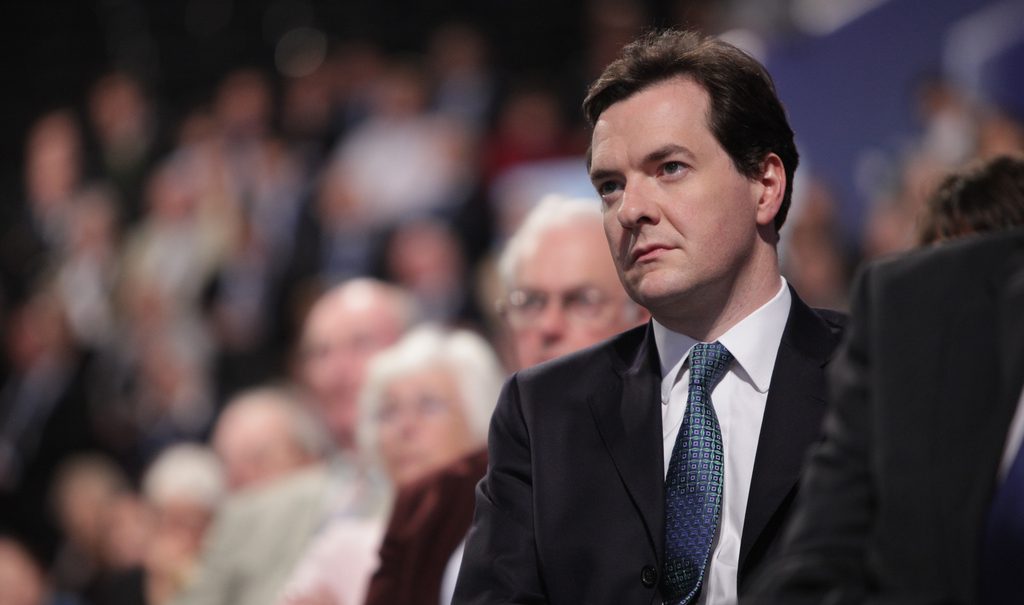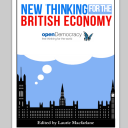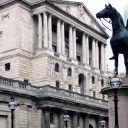Austerity in one country: The case of Britain

George Osborne at Conservative Party Conference. Conservatives / Flickr. Some rights reserved.
When the Guardian reported that the former Chancellor of the Exchequer George Osborne had been appointed Professor of Economics at the University of Manchester, it seemed like an April fools joke or perhaps some fake news. But it turns out to be true, despite the objections from many of the economics students at the university who have for many years railed against the neoclassical teaching they have to endure. Luckily Professor Osborne is not being paid for his endeavours, whatever these may be.
George Osborne is the person responsible for the appalling state of the public finances as a result of policy decisions taken when in office during the period 2010-2016. Of course his policies were also those of the coalition government between 2010 and 2015 and thus the Liberal Democrats bear part of the responsibility for what happened during those years.
But the core responsibility for economic policy in the period since 2010 lies with the Tories, and they are now faced by a storm of problems which have their origins in their doctrinaire and misguided strategies for Britain. What they have done over the past 7 years has resembled Thatcherism on steroids, and the rest of us have had to bear the costs. These have been huge, and focused on the poorest and most vulnerable members of society. As always it is worth recalling what Thatcher said – “there is no such thing as society” – so who cares whether social and economic policies create further divisions, add to income and wealth inequality, and make the poor poorer.
Indeed, a basic mantra of the Tory government continues to be that inequality is good for economic growth and for the health of society, despite the clear evidence that this is untrue. This has been demonstrated by the experience of the Nordic countries and is fully documented in ‘The Spirit Level: Why Equality is Better for Everyone’ by Richard Wilkinson and Kate Pickett. They concluded that, “there is a strong tendency for ill-health and social problems to occur less frequently in the more equal countries….Health and social problems are indeed more common in countries with bigger income inequalities, The two are extraordinarily closely related”.
But then whose interests are the Tories representing? Not the disabled, the sick, the single parents, the unemployed, the homeless, the increasing numbers in low paid and insecure employment, the poorly educated and inadequately trained. There was a time when the Tory party reflected the interests of British business, of those firms and industries that were productive. But as their importance has declined, the hedge fund managers, asset strippers, bankers and property developers have taken their place. The fiscal policies that have been followed have favoured the extractive and destructive activities of the unproductive rich.
Privatisation and deregulation
One of the core principles of Thatcherism is that the public sector is bad and the private sector is good. Hence the raft of privatisations of more or less everything that could be sold so that neoliberalism could be advanced. The results could have been predicted – and were – but no one in Government was listening. There is no evidence that the privatised industries have performed better than when they were in public ownership. Indeed, rather the opposite – with results that have been catastrophic.
Anyone interested in the effects of privatisation should look at the recent book by James Meek, ‘Private Island: Why Britain Now Belongs to Someone Else’. It is evident that market power has been used by former public utilities to engage in ‘tax farming’ – a process whereby prices are raised to enhance profits and with nothing consumers can do to escape extreme exploitation. Instead of creating a share owning class as promised by Thatcher we have instead industries with monopoly and oligopolistic power, often foreign owned, which are in many cases no longer public companies but privately owned and managed. The case of water privatisation speaks for the general effects of these policies, which are worse than anyone could have imagined.
In the case of housing, not only has little new social housing been built despite the huge rise in household formation, but low cost housing has been forcibly taken out of public ownership and almost all of it ended up in the private rental sector. So the supposed objective of creating a property owning class has ended up with a huge increase in the number of households who are privately renting – often at rents that take 50 to 60% of family income. Often these are properties that are poor quality and poorly maintained.
Not only do we have exploitation by private landlords (encouraged by tax concessions from the Tory Government) but to a significant degree the rents are being funded by rent support provided by the government. Thus we have a totally inadequate housing stock which is poor in quality and in quantity and increasingly in the hands of private landlords, where rents are both excessive and in part funded through the public purse. What kind of social policy is this?
All that seems to have been important for Tory Governments is that the public sector be shrunk and the private sector take its place. Indeed, the former Deputy Prime Minister, Nick Clegg, reported during the coalition years that the only concern that Osborne had when there were discussions of tax and social policy was ‘how would supporters of the Tory party react and whether they would benefit’. What kind of calculus is this for a Minister supposedly concerned about national interests?
But the costs of privatisation are not confined to the appalling consequences of the government’s failure to meet housing needs. It is everywhere that there has been privatisation – railways, energy, water and sewage, telecommunications, bus services, airport management and so on. We are only too aware of the failures of many of the private companies that now own and manage these services and of the price gouging that has happened over many years.
Regulation of former public enterprises where it exists has been nothing more than window dressing, for how else could these companies have got away with levels of service that are often poor together with high and rising profits, massive management fees and executive pay and bonuses. For the high profits to be possible, prices had to increase exorbitantly with much of the profits transferred to overseas companies often themselves in public ownership. In many cases we have swapped British public ownership for foreign public ownership. Is there any logic in this? If there is then it is hard to see how consumers have benefited by the changes in ownership and de-regulation that simply increases the profits of companies.
The banking group Santander carried out research on their customers pay and expenditure on utilities and other core outlays, and concluded that over the past decade:
“Basic household bills have increased by an average of 43 per cent in the last decade – more than double the rate of wage growth… Gas and electricity are the biggest drivers of price increases, rising 73 per cent and 72 per cent respectively in the last decade, while water bills have increased by 41 per cent – all significantly higher than inflation at 32 per cent. Council Tax has risen by 27 per cent and TV, phone and broadband prices have all risen by 24 per cent, albeit slower than inflation but still faster than wage growth (19 per cent).”
The findings are summarised in the following Table:
| Year | 2006 | 2016 | Change |
| Inflation | 3.20% | 1.80% | 32.2% |
| Median wage | £19,375 | £23,099 | 19.2% |
| Household bills | £2,148 | £3,063 | 42.6% |
Source: Santander, 2017
Transport is not included, but anyone who travels frequently on trains will confirm how outrageous the fares are, and how much faster these have risen since privatisation. Railway fares in UK are much higher than elsewhere in the EU and it seems that government subsidies in practice simply bolster the profits of the train operators. Standards of service are also lamentable compared with railways in Europe, which are still largely in public ownership. Investment in the railway infrastructure has also been totally inadequate, as the 300,000 commuters who have suffered now for several years from disrupted Southern Rail services can attest. Costs of other public transport are also high – the London underground is extremely expensive – and buses similarly are also costly for regular users who are not pensioners.
That wages and prices have behaved in the way detailed in the above table is scarcely accidental, but in significant part reflects government policy. It reflects the privatisations undertaken by the Tories, together with a belief that deregulation produces the best results. For years the Tories have followed a programme of dismantling regulations, and have followed a policy of two regulations abolished for any one new regulation – irrespective of the consequences. Public resources have flowed into an organisation established by David Cameron called the Red Tape Initiative, the intention of which is to dismantle regulations as part of their neoliberal programme. This did not appear in any manifesto.
The collapse of effective fire regulations has in part been the direct consequence of this policy, together with the underfunding of local government (including the fire service). Unfortunately, it is not surprising that the disaster at Grenfell Tower happened given the general dismantling of local government responsibilities and the subcontracting of housing development and management to private companies. Where private profit dominates and regulation is weak, standards will decline. This is only too evident in relation to social housing.
Cutting Public Sector Employment and Pay
As a direct consequence of Treasury policy under Osborne and now under Phillip Hammond, there have been enormous cutbacks in employment across huge area of the public sector. The fire service and the police have lost thousands of jobs, with consequences for the effective response to emergences and a reduced ability to monitor terrorists and to be able to respond to attacks. Similarly, in education and health there have been budgetary cutbacks and reductions in staff which have had knock on effects on the quality of teaching in schools and colleges and health care in the NHS.
But the government seems largely uninterested in the effects of its policies, and despite the evidence continues to ignore the pressure to reverse their policies on the funding of public services – including those for the disabled and the mentally ill. There is a pressing crisis in social care, as demographics increase the pressure on services that are increasingly inadequate.
Years of pay restraint have been key to the Treasury’s policy of reducing the funding of the public sector. The public services are big employers, much of it highly educated with professional skills and experience that have taken years of training to acquire. This last point is important: it is not sensible to simply compare wage trends between the public and private sectors since former as a whole has a more educated and better trained labour force.
So the argument often trotted out by Government and others that public sector pay should not increase faster than that in the private sector has no merit given the differing composition of the two sectors and quite different needs with respect to recruitment and retention of labour. At the present time key public services such as the NHS are losing skilled and experienced workers at all levels, and are facing a crisis in recruitment both as a result of underfunding and of Brexit. Both of these factors are reversible by government through increasing funding in real terms and issuing guarantees to EU staff with respect to their rights to remain in the UK.
There has been a freeze on public sector pay for many years, and this has reduced the real value of pay for employees across the public sector. The scale of this has recently been documented by a report from UCL and the NIESR for the Office of Manpower Economics which advises Government on pay. That there is now a crisis in recruitment in the public sector is unsurprising given the erosion of the real pay of workers since 2010 which is directly as a result of government policy.
The following table gives a picture of what has happened over the period 2005 to 2015 for a selection of occupations.
It is worth emphasising that these changes in real earnings are annual rates and the cumulative fall in the period since 2010 has been substantial across all of the occupations listed in the table. Thus, in the case of doctors the loss in real earnings per hour 2010-2015 is 22% ,for nurses 7.5% and for police officers some 10%. In practice the decline has been greater than estimated in the table since it does not take account of the losses of real earnings since 2015 – in part caused by the fall in the value of sterling which itself is largely a result of the policies of Government together with the continuation of the pay freeze.
| Median Real Hourly Earnings (ASHE) for 10 Occupations £ per hour | Average annual growth (%) | |||||
| 2005 | 2010 | 2015 | 2005-2010 | 2010-2015 | 2005-2015 | |
| Doctors | 38 | 38 | 30 | -0.1 | -4.4 | -2.2 |
| Radiographers | 22 | 21 | 18 | -0.8 | -3.1 | -1.9 |
| Physios | 18 | 18 | 15 | 0.1 | -2.8 | -1.3 |
| Occupational therapist | 17 | 18 | 16 | 0.5 | -2.1 | -0.8 |
| Nurses | 16 | 17 | 16 | 1.8 | -1.5 | 0.1 |
| Midwives | 19 | 21 | 18 | 2.1 | -2.7 | -0.4 |
| Nursing auxiliary | 9 | 11 | 10 | 2.5 | -0.9 | 0.8 |
| Police officers | 20 | 20 | 18 | 0.4 | -1.9 | -0.8 |
| Prison officers | 16 | 15 | 15 | -1.1 | -0.7 | -0.9 |
| School teachers | 25 | 24 | 22 | -0.7 | -1.3 | -1.0 |
Fiscal austerity – a veil for neoliberal policies
Osborne was responsible for the conduct of fiscal policy from 2010 until he was removed from office by Mrs May in 2016. During this period fiscal policy was lamentable both in its detail and in its effects on the aggregate performance of the economy. In the period immediately before the financial crash in 2008 fiscal policy under the Labour government was in reasonable balance, with the deficit close to that which had prevailed during the post war years. Even the IMF subsequently confirmed that the destabilisation of the budget was due to the cost of bailing out the financial system which was facing collapse in 2008, and was not caused by financial recklessness on the part of the Labour government.
The mantra of the Coalition and subsequent governments from 2010 onwards that the problems with the deficit were caused by the Labour Government is simply untrue. The destabilisation of the budget was the inevitable cost of rescuing the banking system, but the subsequent fiscal policy choices were exactly that – choices by the Coalition and subsequent governments under the economic leadership of Osborne and now Philip Hammond. The current Chancellor has pushed the achievement of the Government’s fiscal targets into the future, and public expenditure is expected to be more or less flat for the next few years rather than continuing to fall as forecast by Osborne. But Hammond is as determined as Osborne to establish a balanced budget in the near future independently of the state of the economy.
While public sector debt as a share of GDP rose sharply between 2008 and 2017 this was largely caused by bailing out the banks, plus the subsequent contraction of GDP which in large part was caused by the tightening of fiscal policy. Even with a much higher level of public sector debt as a share of GDP, now approx 90% compared with 30-35% prior to the financial crisis of 2008, there was still capacity for additional borrowing in order to finance government expenditure, and thus avoid the unnecessary losses of output that ultimately occurred.
Osborne chose to set targets for the fiscal balance which had no foundation in the needs of the economy, but reflected a preference for a smaller state – a level of state activity that reflected neoliberal objectives irrespective of the consequences for public services and the performance of the economy overall. There was a sharp fall in GDP after the financial crisis and subsequently GDP growth has been weak and well below trend. The fact that there has been such a weak recovery is in part the direct result of the fiscal policies pursued by Osborne.
VAT was raised in 2011, which is highly regressive, and while an expansionary fiscal policy was needed to re-establish economic growth Osborne chose to follow the opposite in pursuit of the chimera of a small state and a balanced budget. One of the obvious results of the fiscal contraction was economic growth that was well below trend and tax receipts that lagged.
Not even Milton Friedman, the economic guru of the right, would have applauded this policy stance, and he well recognised the need for fiscal and monetary policy to behave counter-cyclically. This is precisely the opposite of what Osborne did and, not surprisingly, the target for fiscal balance moved further and further into the future as the economy limped along with extremely low growth rates. Aiming for fiscal balance irrespective of the state of the economy is something Friedman would never have supported, and neither would Keynes or most other macroeconomists of note.
The other key aspects of Osborne’s fiscal strategy were also counter-productive, both individually and in the aggregate. It is worth quoting the Resolution Foundation in their overall assessment of tax policy:
Such tax cuts have obviously helped to support living standards for different parts of society, but they have also come at a cost to the Exchequer. Using OBR estimates of the costs of income tax, corporation tax and fuel duty giveaways at the time they were made,…..the total cost is set to add up to £45 billion by 2021-22, which is almost three times the expected size of the deficit in that year. Indeed, in the absence of this suite of tax cuts, public sector net borrowing would be in surplus by 2018-19.
It is worth noting the Foundation’s estimates of the cumulative costs of the various tax changes between 2010-2021/22. The cuts in corporation tax are estimated at £72bn, changes to the personal tax threshold at £132bn and the freezing of fuel duty at £62bn. There are specific arguments that can be marshalled against all of these tax changes plus the cut in the top rate of income tax from 50% to 45%, but it is essential to note that the changes were in all cases discretionary, and were made by Osborne irrespective of the general state of the economy.
Corporation tax has been reduced from 28% in 2010 to 20%, with the aim of reducing it to 17% by 2020. By then the UK will have the lowest rate of any major country and will be well below the OECD average of 25%. It is hard to see the economic case for reducing the rate of corporate taxation other than a determination to undercut our competitors. The result is simply to add to the fiscal deficit while at the same time doing more or less nothing to increase the level of private investment which has remained weak over the whole period since 2008. Cutting corporation tax is not an effective way to increase the rate of investment – there are more strategic tax incentives that are less costly in terms of revenue lost. A considerable share of the cuts in tax will have accrued to foreign owned enterprises.
There is clearly no economic case, quite the opposite, for the fuel duty changes. From Spring 2017 a litre of petrol is 28 pence less than it otherwise would have been under the previous tax regime. Clearly the primary aim of fuel duty taxation was to raise revenue and this has partly been reversed. As a secondary objective increases in the rate would have achieved something towards reducing the impact of carbon emissions and thus contributed to targets relating to air quality and climate change. Policy has therefore made the achievement of these targets even more difficult despite the evidence that transport is a major source of CO2 emissions. Clearly policy was driven by purely political objectives, since cuts in the real level of fuel duties will have been popular with corporations and with those voting for the Tory Party.
The uprating of tax allowances seems in principle to have been a sensible strategy and it was certainly popular – not least with the Lib Dems who pressed hard for the changes. The target is to take the level to £12,500 by 2020, which would be some £4,000 higher than if just uprated with inflation. As we can see from the data above, the changes are extremely costly for the Exchequer and although some of the gains will have been received by those on low incomes in practice most of the benefits go to those in the higher rate bands since the tax free sum would have been taxed at a higher rate. In effect this is a very expensive way to help those with low incomes, and more targeted tax and expenditure changes would have achieved better outcome at much lower cost for the Treasury.
The losses to the public revenue due to the discretionary changes in tax rates, together with a fiscal policy that was deliberately contractionary in its impact, became essential to the case being made by Government for austerity. But there really was no case for austerity, and the setting of arbitrary targets for the deficit together with tax cuts had no merit. Indeed, austerity was and is a veil for other economic and social objectives – to roll back the state to a target level of 30% of GDP irrespective of the effects of such policies on what makes the UK a civilised and caring society.
Assessing the Costs of Austerity
Discretionary tax increases and spending cuts by Government since April 2008 are around 10.6 % of national income – some £200 billion at 2017 prices. Of this fiscal tightening, 16% were net tax changes and 84% reductions in public spending, with some two-thirds of the fiscal contraction achieved by 2016-2017. Policy decisions were taken which loaded the fiscal adjustment on expenditure cuts with a much smaller role for tax changes in the conduct of fiscal adjustment. Most of the tax changes benefitted the rich, especially the cut in the top rate of income tax. During this period the share in total government receipts rose sharply for council tax, VAT and NICs, and fell for Business Rates and Corporation Tax.
The increase in VAT and council tax were highly regressive with the impact much greater on those with lower incomes. One of the most egregious changes was the imposition of the so called ‘bedroom tax’ on households with a ‘spare room’, despite the fact that there existed no alternative social housing for those affected.
It is also clear that in the early stages of the coalition government that the impact of fiscal adjustment on the real economy was much greater than the Treasury had assumed. It has been estimated that the loss of GDP between 2008 and 2016 was £5,700 per head. This represents a permanent loss in part due to the collapse of the economy after the 2008 financial crash, and in part due to the weak recovery afterwards which had superimposed on it the contractionary fiscal policy of the coalition government. This loss of per capita income was much greater than in previous economic downturns in the 1970s and 1990s when management of the economy was much better aligned with economic needs.
It is worth detailing how drastic the changes in government policy have been since 2010, changes which reflected policy choices and a determination to reduce the size of the public sector irrespective of its impact on the social, economic and political system. It is evident that many people in government do not understand the critical role that that state plays in a modern economic system. Not least the fact that much of public current expenditure has a significant investment element both directly and indirectly. This is most evident in the case of education and training, but the same is true of investment in housing and in health, in the legal system, and social services as well as in infrastructure. Much technical innovation originates in state supported research programmes, often undertaken by universities.
The swingeing cuts we have seen in recent years in public expenditure have nothing to commend them. In the period between the 1950s and 2010 government spending increased in real terms at an annual rate of 2.9% and the UK had a level of public expenditure relative to GDP comparable to most other OECD countries. Since 2010 the increase in government spending has fallen to an annual rate of 0.3% with the result that per person real spending per head has been flat. By 2020/21 per person real government spending per person will have fallen by 4% compared to 2010 when the coalition took office.
Within government there have been catastrophic cutbacks in departmental spending (17% overall) with cuts to education (14%), defence (18%) and Communities and Local Government (25%). The NHS has had an increased level of funding (5%) but this is totally inadequate to meet demographic growth and the needs of an ageing population. Welfare spending per person (excluding pensioners) has fallen 10% in real terms since 2010. All of the increases in child benefit made between 1999 and 2009 have been reversed, and job seekers allowance is now lower than at any time since 1992.
It should also be noted that public investment has fallen to levels not seen in the post-war period, with results that are everywhere apparent in terms of a crumbling infrastructure. The gap between needs and performance is most evident in the case of housing where investment by government has more or less ceased despite the recommendation of the Barker Commission that we needed an annual investment of 250,000 houses to keep pace with demand.
Government rejected the advice of many economists who said it should expand its investment programme during the post 2008 downturn so as to expand demand at a time when borrowing costs were extremely low. The enormous shortage of affordable housing in the UK has its origins in the failure of government to undertake the required public investment.
One of the consequences of the cutbacks in Government spending has been an enormous loss of jobs in the public sector. In Local Government the cuts have been about one-third, with a loss of critical services for which there is no private sector provision such as libraries, parks, children’s and youth services etc. Overall General Government (including Local Government) now has total employment below 5million for the first time this century, with an estimated loss of jobs of about 500,000 since 2010. The biggest workforce cuts are health and social services (35%), armed forces (25%) and police (22%). How could anyone defend such an erosion of public sector employment and the associated services?
Along with the losses in employment have gone cuts in the real pay of employees. Public sector pay was frozen in 2011 until 2013 and then was subject to a 1% cap thereafter. As we have seen above this has massively eroded the pay of employees and it is unsurprising that many key sectors face major problems of retaining and attracting labour. It has been reported that since 2011 25% of newly qualified teachers have left the profession on account of low pay together with excessive working hours. Average public sector pay was £26,780 in 2009 and is projected to be £25,430 in 2020 – a fall of £1,300 which can be compared with a rise of £1000 for average private sector pay over the same period.
The Tories have tried to create an ideological shift against the public sector by diminishing public employees as ‘bureaucrats’ or ‘penpushers’. The denigration of experts that has taken place is part of a longer trend in under-valuing technical expertise and paying those with engineering and other technical skills much less than in competitor countries such as Germany. We are now witnessing the consequences of these attitudes and policies as the quality and quantity of public administration has fallen dramatically. Not least in the capacity of central government to deal with the complexity of Brexit and all the activities that are affected by the ‘planned’ withdrawal from the EU.
A final summary statistic that strikingly portrays the failure of Osborne’s strategy is that real household per capita income was a mere 1% higher in 2017 than it was a decade ago. In the years before 2007 the average annual increase in household real per capita income was 2.6%, however since then it has fallen to a mere 0.3%. This has to be the worst performance by any post-war government in the UK.
The economic consequences of Mr Osborne
In 1925 Keynes wrote a very powerful analysis of the failures of government economic policy which he published in a book entitled ‘The Economic Consequences of Mr Churchill’. The decision that Churchill took at that stage to return to the gold standard at an over-valued parity directly led to massive unemployment which contributed to the Great Depression of the 1930s.
It is evident that when Chancellor Mr Osborne knew nothing about the effective conduct of economic policy. As a result the UK looks set to experience a decade or more of insecure employment and stagnant real incomes within a society that is deeply fractured. At the same time, the rich will get richer.
The UK is a deeply unequal country and one that is getting more unequal by the day. There was a remarkable rise in inequality from the 1980s, with the Gini coefficient increasing from 25% in 1979 to almost 40% in 2010. It is remarkable that the Gini in 2016/17 was higher than in all the years since 1961 except for the short period of 2007-2010.
The Resolution Foundation in ‘The Living Standards Audit 2017’ concluded that:
“In 2015-16 the share of income going to the top one per cent reached 8.5 per cent, broadly returning to pre-crisis levels although below 2009-10’s record peak of 8.7 per cent. Both these years of high income shares reflect, in part, income being shifted between years in response to tax changes.”
So the rich not surprisingly managed to protect themselves from austerity while incomes for the other 99% at best stagnated after the 2008 financial crisis, with a further widening of regional income inequality. And how successful has the Osborne strategy been in reducing the risks faced by the economy? A report from the OBR in July concluded as follows:
“A decade after the outbreak of the financial crisis and recession, net borrowing is well down from its peak. But the budget is still in deficit by 2 to 3 per cent of GDP – as it was on the eve of the crisis – and net debt is more than double its pre-crisis share of GDP and not yet falling. As a result, the public finances are much more sensitive to interest rate and inflation surprises than they were.”
This doesn’t sound like much of a success story, and its unsurprising that the population have had enough of austerity and the government and political party responsible. One could add that the public finances are also subject to a wide range of other risks including the economic meltdown caused by Brexit and the high probability of another financial crisis. The UK is now in a much worse state to deal with imminent risks than it was before 2008, not least because of a decade of failed economic and social policies.





